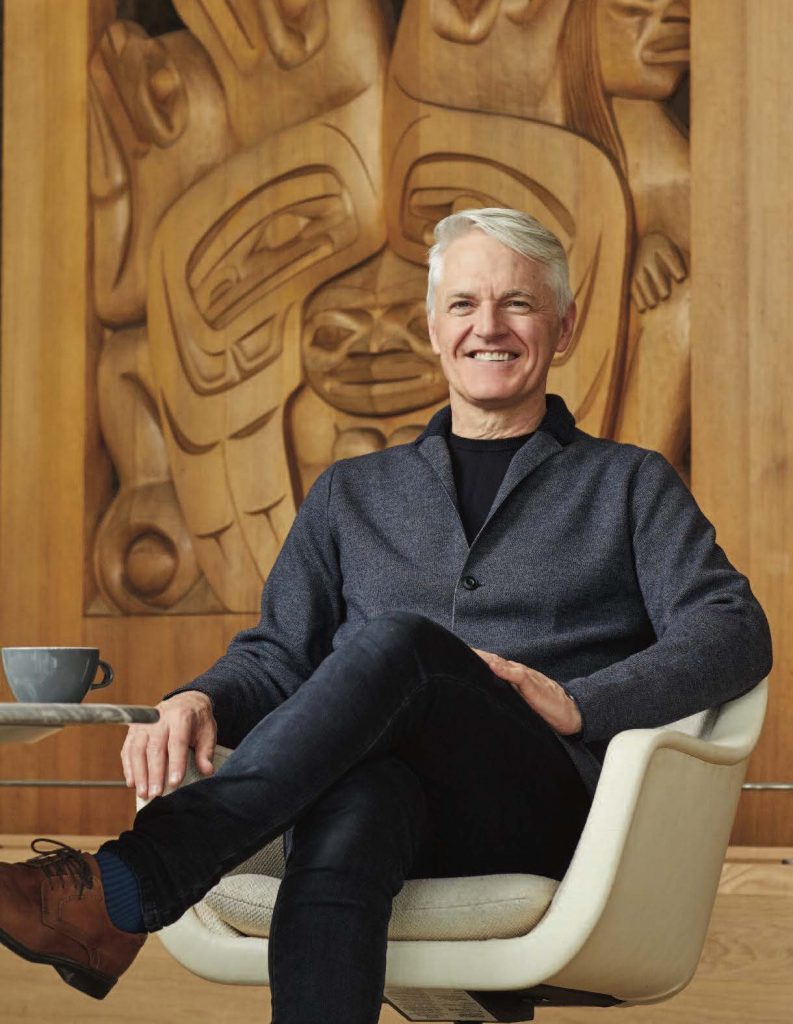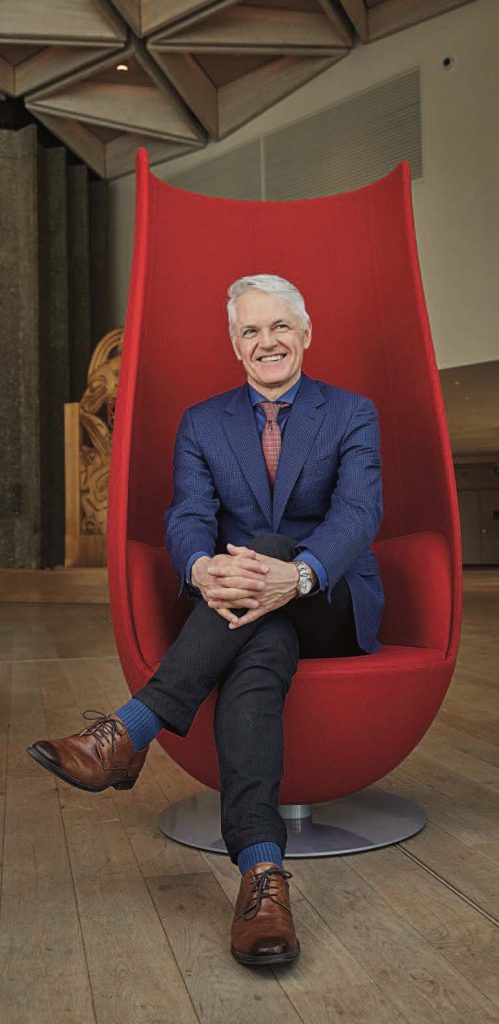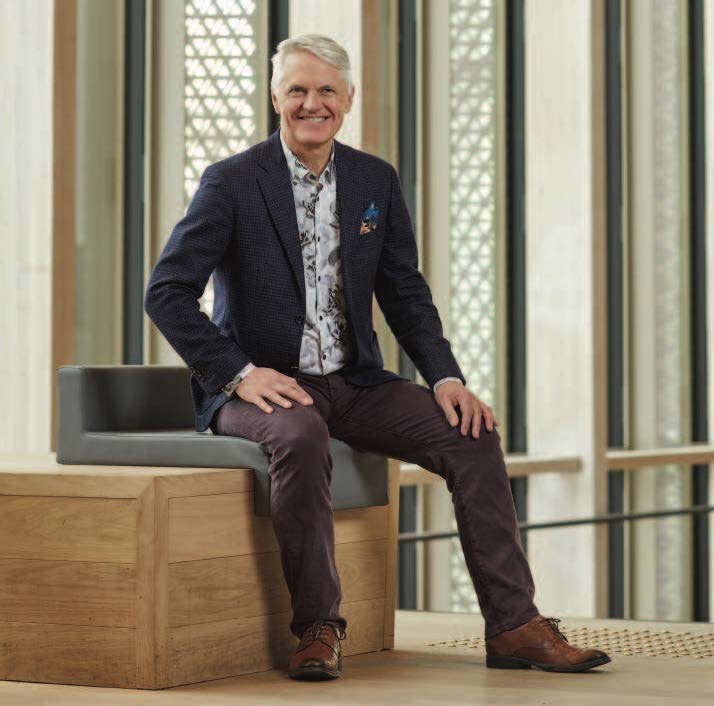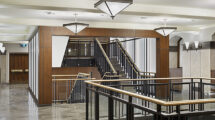
By Iris Winston
Leading with Vision
Christopher Deacon is winning new audiences by boldly redefining Canada’s NAC for the future.
“Our stories define us.” Those words were spoken by Christoper Deacon during his acceptance speech last June as the new president and CEO of Canada’s National Arts Centre (NAC). They are not only part of his vision for one of this country’s major cultural institutions, but also a driving tenet in his own career journey.
He was very young on the day that he and his father walked along Ottawa’s Elgin Street and paused near a huge building site, protected by heavy fencing. His father lifted him up so that he could look through one of the peepholes in the giant hoarding to see the start of the work in progress.
When the boy asked what the huge rocks and the massive hole were going to become, his musician father replied, “That’s our national arts centre.”
So, Christopher’s first connection with the building, that has now been his workplace for some 32 years, began while construction was underway.
He was a little older when he accompanied his father, then a freelance music reviewer for the Ottawa Journal, to numerous events at the National Arts Centre after it opened its doors in 1969.
“I saw many different performances with him and whenever my high school class came here,” Christopher reminisces, as he glances out of a window of his office in the recently renovated and enhanced building. “I fell madly in love with the place from the outset.”
As an 18-year-old, about to head off to the University of Toronto, where he would begin training as a composer, he took a summer job at the NAC.
“It was 1977 and my job was to help out in the main kitchen, babysitting the dry goods storeroom and unpacking fruit from Zunder’s Fruitland,” he explained in a speech at the Rideau Club earlier this year.”
On one occasion he was asked to “come upstairs to restock the glasses in the boss’s office.”
“I was in and out of the president’s office in less than a minute,” he says. “Had anyone suggested that this would one day be my office, no one would have believed it. Certainly not me. It would not have occurred to me in a million years, that this is where I would land. To me, it’s still a fairy tale.”
The way in which his parents met, also played its part in the magic behind his story. His mother, who had left her native Ireland to become a nurse in London, England, had just finished a 12-hour night shift and was ready to go home for some much-needed sleep. But it was VE Day — Victory Day, May 8, 1945 —and her roommate insisted that it was more important for her to be part of celebrating the end of the World War II. They joined the crowd in Piccadilly Circus where she met a Canadian soldier. Romance blossomed and soon she became a war bride and moved to Canada. The couple settled in Montreal and later moved to Ottawa with their five sons — Christopher was the youngest — when their father was working in public relations for the Centennial Commission as it prepared for Canada’s 100th anniversary.
Music always played a large part in Christopher’s life from the time he heard his father practising the jazz clarinet and attended concerts with him until he continued his music studies and then, as a father himself, accompanied his youngest daughter on the flute, while she played the violin.

“We even played publicly on a couple of occasions when she was seven or eight,” recalls Christopher. “She probably played better than Daddy did, though once you’ve learned an instrument you can pick it up again.”
Arts administration, rather than performance or composing, became the focus of his career, soon after he graduated. His early positions included leading a new music series in Toronto, being the director of operations with the Kitchener-Waterloo Symphony and the coordinator of the National Youth Orchestra of Canada. In 1987, Christopher joined the NAC orchestra as tour manager, moving on to be the orchestra manager two years later and then its managing director in 1996.
The first person to have risen to the top from within, during the half century that the NAC has been in existence, Christopher’s appointment as president and CEO was rooted in “a rigorous and disciplined search to find the best arts executive to lead Canada’s National Arts Centre,” says the NAC board chair Adrian Burns, who headed the recruiting committee. “We found the right person right here at the NAC to provide the vision and leadership necessary to guide the organization into its next half-century. Few people know the NAC as well as Christopher Deacon.”
His predecessor Peter Herrndorf, who led the NAC for 19 years, is equally enthusiastic about the selection. “Christopher Deacon is a champion of the performing arts in Canada,” he says. “He’s got a proven record as a risk-taker and as an adventurous arts administrator leading highly ambitious projects.”
For example, as the managing director of the NAC orchestra, he led two major orchestral tours, to China in 2013 and the UK in 2014. He also headed the ambitious multimedia presentation Life Reflected, in which four Canadian composers were commissioned to tell the stories of four Canadian women in music, movement and words. Performed during the Canada 150 tour, Life Reflected will also be part of the NAC orchestra’s 50th anniversary tour of Europe.
Now, some 50 years after the NAC opened, “that same kid who was asked to refresh the bar glasses has been asked to refresh the institution.” He was also the man Peter Herrndorf tapped to oversee the massive architectural rejuvenation and production renewal of the NAC — projects with a combined budget of $225.4 million.
“People give me a little more credit for that than is reasonable,” says Christopher, who chaired the steering committee through the project. “First, it was Peter Herrndorf’s vision. Second, it was the work of the brilliant architects, Diamond Schmitt, the project manager and the whole team. The role I played was to ensure that the values of the institution were reflected in the renovation and that all those involved be reminded constantly that this was a centre for the performing arts. We also wanted to make sure that senior management and artists didn’t feel it was something being done to them and to ensure that they were involved [throughout the process]. The project was really about renewing the institution through renewing the building.”
For Christopher, now 60, that work and heading the organization are more than the upward trajectory of a successful career. Rather, “being part of the NAC team is a calling.”
“It’s a great challenge, but it’s also a great honour to be at the head of a national institution for the performing arts where the most exciting artists from across the country are performing,” he says.
“It’s exciting because it’s our 50th anniversary and that is following the culmination of the renewal of the public spaces and production facilities of the building,” he continues, adding that the recent launch of the National Creation Fund adds to the excitement.
(The NAC’s National Creation Fund will provide up to three-million dollars a year from donations to fund 15 to 20 new works in various disciplines).
Christopher defines his philosophy of leadership as recruiting the best possible people— he was instrumental in hiring Pinchas Zukerman and then his successor Alexander Shelley to lead the NAC orchestra, for example — establishing clear goals, making the appropriate resources available and then standing back.
“Give them room to breathe,” he says. “When you hire brilliant people, they are very motivated and they can chart their own course.”
As he sees it, his charge of the NAC is “almost a sacred responsibility to provide an enriching experience of the performing arts that gives the opportunity for profound reflection and regeneration. From the day the doors of the NAC opened, creating, producing and presenting the best and most exciting performing arts from across the country has been at its core. It also brings to Canadian audiences in the capital, some of the most interesting arts happening around the world and also helps Canadian artists tour.”
“In some cases,” he adds, “audiences can be profoundly moved and even changed by the experience, whether it’s ballet, music, theatre or a singer-songwriter. People all find their own way in the performing arts to appeal to a multitude of tastes.”
“Having said that,” he continues, “I see my piece in the chronology of leadership as being vitally important that the NAC engage a wider, more diverse and younger range of audience members. It’s not a question of commerce. Rather, it’s a question of public service and engaging the whole country in the performing arts. I think that the national centre of the performing arts needs to be a place that is central to the life of the country.”
This, he emphasizes, means bringing-in a broader range of audiences and ensuring that everyone feels welcome and is not intimidated by the grandeur of the building.
“There is still some sense that the NAC is ‘not the kind of place I would go’ [among some groups],” says Christopher. “That’s exactly why we’re excited about the renovation of the building. It’s enabled us to put in a coffee shop through our partnership with Equator Coffee. There’s free Wi-Fi and electrical outlets all around. We have college, university and high school students coming to work at projects here in the afternoons. We are offering free animation programming, such as Toddler Tuesdays. We have painting for seniors and events like the Big Bang Festival. All these things are bringing foot traffic through. People are starting to discover that this is a place where they can hang out. It helps reposition this building as a place for everybody.”

He notes that the large number of free events on offer, as well as the wide range of pricing for most performances, opens the way for anyone who wants to attend.
“One of the interesting challenges we have, is not so much the obstacle of price, but the perception of cost,” he says. “In any given year, there are dozens, if not hundreds, of free performances. In addition, we have such programs as live rush [same-day cheap tickets] targeting people under 30 to make that gate wider.”
He goes on to point out that as “the next generation is replenishing and engaging,” the institution will change.
“It’s going to mean that the NAC looks and feels different,” he says. “But an artistic organization is only going to thrive if it is renewing and changing constantly. I believe that we can make the transition more relevant and impactful for younger and more diverse audience members. We can still provide the opportunity for profound engagement in the performing arts for the audience members who have been coming to the NAC almost from the time the building opened.”
He sums up his vision for the future of the NAC by noting that “the fundamental work of creating great performing arts” is a job that is never completed.
“People are writing new songs, creating new ballets, writing new plays all the time and you couldn’t possibly program them all,” says Christopher, who sees a primary part of his mission as inviting a wider community to enjoy all that the NAC has to offer. “What I can do is help the whole institution look towards an engagement with the younger and more diverse population. That is the key thing for me.”
“In a sense, this is the job that my whole career has been preparing for,” he says. “It’s my turn at bat and I want to hit a home run. When I eventually retire, I’d like to be able to say that I used my turn well.”






